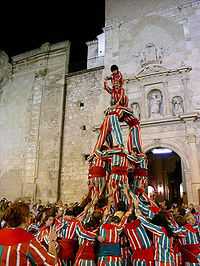Muixeranga
| The Catalan / Valencian cultural domain |
|---|
 The muixeranga in Algemesí |
|
Language |
|
People
|
|
Geo-political divisions |
|
Government and politics |
|
Traditions and symbols |
The Muixeranga (Valencian pronunciation: [mujʃeˈɾaŋɡa] ![]() Muixeranga ) is the collective name given to the performance of ancient street dances and human castles, originating in the Valencian Community, which are still preserved in the town of Algemesí, 30 km (19 mi) southwest from Valencia.
Muixeranga ) is the collective name given to the performance of ancient street dances and human castles, originating in the Valencian Community, which are still preserved in the town of Algemesí, 30 km (19 mi) southwest from Valencia.
The muixeranga is much more than an artistic acrobatic dance. It is a collection of ancient human choreographies of enormous plasticity illustrating various figures and shapes, which are held during the Algemesí town festival (September 7 and 8th), in honor of the so-called Virgin of Health (Mare de Déu de la Salut).
The Muixeranga resembles the modern castellers in many ways, the latter being spread all over Catalonia. Both traditions share the same origin, the Moixiganga, once found throughout the Iberian Peninsula. Muixeranga differs from castellers mainly in that the Muixeranga has a more religious background, is accompanied by a dance, and does not care too much about the height of the human towers, trying to find a plastic, figurative scene.
Characteristics
The people composing the castles are usually a group of men, of virtually any profession, but preferably of strength and physical skill. Nowadays, around 200 men participate in the plastic figures, but historically there were not more than thirty. There is a master, or conductor, which coordinates the dance and the human castles, towers and other figures, as well as admitting and training new people.
The clothes are idiosyncratic in many ways. They are composed of a shirt, trousers, farmer's shoes and sometimes a special hat. The fabric is coloured with vertical red and blue stripes on a white base, like a harlequin. It seems that this strange appearance is unintentional. Older people can still remember that they were once made from old mattress fabric.
Origin and evolution
There are several theories on the origin of muixeranga, especially in relation to its name. The first theory advocates that the word comes from the Arabic word mochain, meaning "mask". A second theory links it with ancient processions held on the streets to commemorate some special event.
Even though the tradition in the Iberian Peninsula may date back to the 13th century, the first written record of the muixeranga in Algemesí can be traced to the first third of the 18th century. However, its constant, strong presence suggests a much older origin.
If we rely on references, the first solemn celebrations of the Virgin of Health happened in 1724, so this is the earliest that the muixeranga could be linked to this celebration. However, the first concrete date comes from the town account book in the year 1733, when the dulzaina players employed in the festival were given an annual stipend.
Music and symbology
 |
The Muixeranga song
Performed by Xavier Richart |
| Problems playing this file? See media help. | |
The dance is accompanied by the music of tabalet (a drum) and dolçaina (valencian shawm), with a very old characteristic tune, of unknown author.
Some people struggling for the recovery of the Valencian culture and its language, such as Joan Fuster, have vindicated the music of the Muixeranga as an anthem for the Valencian Community.
See also
- Acrobalance
- Acrobatic gymnastics
- Govinda sport, events to celebrate the birth of Krishna
- Gymnastic formation
- Human pyramid
Notes
References
- Bertran, Jordi: El Ball de Valencians. De la dansa a les torres, Quaderns de la Festa Major, 12, Ajuntament de Tarragona, 1997.
External links
- Non-official web of the Muixeranga (part of the information of this article has been extracted from this web, with permission)
- Nova Muixeranga from Algemesí
- Web Official of Moixiganga of Vilanova and the Geltrú
- Facebook Official of Moixiganga of Vilanova and the Geltrú
| |||||||||||||||||||||||||||||||||||||
.svg.png)